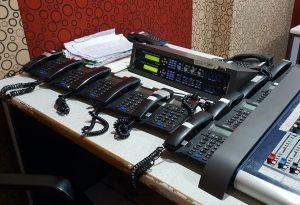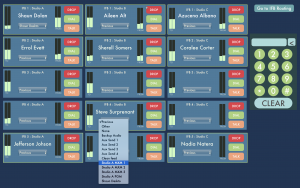SVG Tech Insight: Telephony in the Modern Video Production Facility
This fall SVG will be presenting a series of White Papers covering the latest advancements and trends in sports-production technology. The full series of SVG’s Tech Insight White Papers can be found in the SVG Fall SportsTech Journal HERE.
Background
While the underlying telephony transport method has undergone a shift in the last decade, the workflow in many facilities has remained largely unchanged. This white paper will explore a brief history of telephony in broadcast and production facilities to identify the challenges that are sometimes taken for granted, then moves to explore the solutions provided by modern Voice over IP (VoIP), Audio over IP (AoIP), and control mechanisms.
Legacy Workflow
Audio transported over the Public Switched Telephone Network (PSTN) has long been an afterthought in some video-centric facilities.
For example, while IFB and engineering coordination are critically important links between talent and their production teams, the workflow and technology used to facilitate this communication has stayed mostly the same in some operations. Many facilities still have first-generation digital telephone hybrids in service, racked up in a far, dark corner of a technical operations center, connected to Plain Old Telephone System (POTS) circuits.
Likewise, while “phoners” and other contribution audio from the PSTN is not a producer’s first choice to get a guest on the air, it is often the only viable solution in late-breaking situations and the COVID-19 world; a cell phone is many times the lowest common denominator between content producer and contributor. Despite broadcasters using telephones during some of the most critical moments of a developing story, the duty of converting the inherently 2-wire POTS circuit to 4-wire audio is often relegated to an ancient telephone hybrid.
Control
The control method for legacy POTS hybrids has remained largely unchanged as well. In facilities that are still using this legacy technology, it is not uncommon to see dozens of analog phones mounted to the wall or scattered on a desk, as pictured. Each phone is dedicated to one hybrid to allow dialing out or individually answering calls. Even in the best-case scenario, an enterprising engineer has built a switching mechanism that allows one phone to be used with multiple hybrids, but only one at a time in one physical location.
Monitoring
What about monitoring? Again, creative engineers have come up with inventive tally systems to see what hybrids are currently in use through lightboards or other means, but these systems leave a lot of questions unanswered, such as:
- Is the talent in the next live shot connected to the correct hybrid?
- If not, which hybrid are they connected to?
- What are the audio levels in and out of each hybrid?
- How can I dial the reporter manually?
Legacy Technology
POTS circuits are still pervasive in many corners of the broadcast and production industry. While most radio and audio facilities have moved away from analog lines, some circles have increasingly resisted change.
The biggest pain point with POTS circuits is cost. I frequently speak to broadcasters who pay more than $50 per month for each POTS line they have.
Compounding this pain of increasing POTS cost is decreased reliability. The major incumbent telecom providers are racing to abandon copper phone networks. Even where “real” copper POTS lines are still available, these providers are running out of technicians who know how to maintain them. The notion of a POTS line being more reliable than an IP-based circuit no longer holds true.
While many content producers have moved to VoIP, some still use POTS because it “still works.” While this may be true for now, the sunset is gradually and painfully coming. Many facilities have moved to VoIP for their backend, but use Analog Telephone Adapters (ATAs) to connect to their aging hybrids. While this temporarily reduces telecom costs, these facilities miss out on the better call quality, higher reliability, and modern control options offered by modern broadcast telephony solutions.
A Paradigm Shift
While these telephony workflows and technologies in a broadcast facility were merely products of their time, it is important to reevaluate them in the context of modern times. New solutions are now available to remove the roadblocks inherent to legacy technology and take advantage of modern VoIP, AoIP, and control systems.
VoIP
Voice over IP has been steadily increasing in popularity since the wide adoption of Session Initiation Protocol (SIP) in the mid-2000s and has reached critical mass. It is rare to find an office with anything but SIP phones on desks at this point. This same technology can bring similar benefits to broadcasters.
The initial draw to VoIP, for many, is the cost savings. Switching to VoIP saves broadcasters I speak with 50-75% on their recurring telecom expenses, regularly.
However, not only do telecom costs drop dramatically when switching to VoIP, reliability skyrockets. Telecom companies are actively maintaining and growing their IP backbone. What’s more, providers can offer divergent paths and redundant circuits with automatic failover in ways that were just not possible with POTS. Another excellent feature of VoIP is the granular troubleshooting it affords. The widely accepted SIP protocol, standardized by the Internet Engineering Task Force (IETF), includes more than 40 different error messages that can tell you why a call was not completed. The SIP messaging and audio flows can be analyzed by tools such as Wireshark, allowing an engineer to see precisely what is going wrong. This gives us far more information to get the problem resolved faster — gone are the days of calling your provider with no more information than “there’s no dial tone.”
Modern Workflow
Multiple AoIP protocols are now baked into nearly any relevant gear in a production facility, including into VoIP-to-AoIP gateways. However, what had been missing from these simple gateways was a method of unified control. Without this critical control layer, VoIP to AoIP gateways are used essentially within the same confines of the legacy workflows discussed earlier.
Pictured is an example of a custom HTML5 user panel that allows viewing of line status, caller ID, audio levels, and audio routing. It also allows a user to dial any IFB and talk back to any IFB. In this way, full control of an entire facility’s telephony system can be realized. This is accomplished through the Telos VX Enterprise, a VoIP multi-line call handling engine for broadcast, and Axia Pathfinder Core PRO, a full-scale orchestration platform.
Best Practices
For anyone interested in modernizing their facility’s telephony service and workflow, we can suggest a handful of best practices that can help ensure workflow cohesion and flexibility in the future.
VoIP Provider
Partner with a VoIP provider and product offering that suits your needs. If availability of telephone IFB and contribution audio is not optional for your productions, consider ordering a dedicated high-Quality of Service (QoS) SIP trunk circuit. While higher-priced than other solutions provided over the top of internet circuits, these dedicated circuits typically include an SLA, guaranteed bandwidth, and give you the best chance of all audio and SIP messaging being delivered reliably with low latency. This type of circuit is the closest you will get to legacy circuits, such as POTS or T1, with regard to availability.
VoIP Engine
Ensure your VoIP engine is well-suited for broadcast and live production. It should have smart workflows built in that can handle most of your needs automatically, as well as an API to allow custom control from third-party applications. Consider if its hardware platform has resource availability for growth. Your VoIP engine should also be priced to your needs, meaning that you are only paying for the functionality you need right now. Licensing options can allow for increased capacity when you need it. Of course, your VoIP engine should allow for compliance or compatibility with audio interoperability standards, such as AES67 and SMPTE 2110-30. For facilities where network audio is not yet the standard, ensure that the VoIP engine you choose easily integrates with network audio gateways that provide signals in your preferred format, such as analog, AES3, or SDI.
Orchestration
A telephony orchestration platform should allow full integration into your VoIP engine’s functionality. Make sure it will mesh seamlessly into the smart workflows already in place in your VOIP engine by default but can allow overriding them as needed for special operations. The platform should allow you to create custom user panels, using widely compatible methods such as multitouch-friendly HTML5. Additionally, evaluate if the orchestration platform you’re considering can integrate with a wide variety of other protocols, such as those used by your intercom, audio routing, and monitoring systems.
Hardware Control
In many cases, hardware control is equally important as software control for fast-moving workflows. Find a VoIP broadcast solution that includes options for dedicated hardware controllers that allow for audio, monitoring, and basic control. Intuitive design and useability are critical here, and dedicated hardware controllers can help bridge the gap for staff members who are less comfortable using software for basic functions. Alternatively, make sure the VoIP engine and/or orchestration platform you choose allows for interfacing with generic hardware controllers, such as via IP messaging or simple GPIO.


